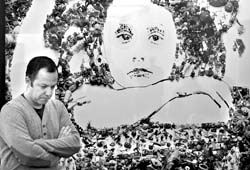Parade of sincere imitations

The solo show of works by the famous Brazilian mixed-media artist Vik Muniz, called Vik Muniz: Expertise, has opened at the PinchukArtCentre Gallery in Kyiv. On display are 50 works created in 1997-2007, which comprise a kind of retrospective.
Muniz was born in 1961 in one of Brazil’s largest cities, Sao Paulo. Today he lives and works in New York. Since the early 1990s Muniz has been showing his works in galleries all over the world, including the BALTIS Contemporary Arts Center (UK) and contemporary art museums in New York, Montreal, San Diego, and Seattle. He has had shows in Tokyo, Paris, Athens, and Dublin, and he represented Brazil at the 49th Venice Biennale.
In the last two decades Muniz has been guided by the belief that there are no more things to paint or photograph, so you have to create your own. He makes his works of art using novel media, including peanut butter, garbage, jam, cotton batten, nails, thread, soil, sugar, chocolate, and even such expensive things as black caviar, gold, and diamonds. After making a photograph, he destroys the negative, leaving only the original.
But one must tread lightly in speaking about originality because replicas of paintings by Corot, Constable, and Piranesi (made of yarn) Andy Warhol (jam), Guido Reni (garbage), and Rodchenko (portrait of Maiakovsky in black caviar) despite the authenticity of these novel media, remain imitations. Moreover, Muniz jumps from style to style, device to device, as though he is composing a guide to contemporary art. He has made collages, bricolages, different installations, and landscape art (300 to 400-metre-high works created with the aid of bulldozers and photographed from a helicopter) - all in order to photograph them and destroy the originals.
As a result Muniz is definitely a child of postmodernism, who does not present anything of his own, just quotations and photocopies of what is already a copy. For real artists, a gesture, a striking idea (a work’s most brilliant feature) are no less important than the work itself. Here Muniz strives for extraordinary actuality: what he is doing is actually a gesture, nothing more. It is not the thing that is depicted that is important (because the image is already well known in other artists’ works) but the media and the artist’s efforts. This is the complete triumph of technology, where even the result does not mean much.
In a certain sense this is much more honest than exhibiting badly painted pictures or a home video, and passing it off as the latest artistic truth.






